Effect of Cold Rolling Prior to Annealing on the Grain Size-Energy Losses Relationship in a Low Carbon Grain Non-Oriented Semi-Processed Electrical Steel
Abstract
1. Introduction
2. Materials and Methods
3. Results and Discussion
3.1. Effect of Plastic Deformation on Microstructure and Magnetic Properties
3.2. Effect of Annealing Temperature on the Microstructure
3.3. Magnetic Properties
3.4. Magnetic Properties-Grain Size Relationship
4. Conclusions
- Plastic deformation applied to grain non-oriented electrical steel sheets caused a significant increase in energy losses, from 10% for 5% strains to a 50% increase in energy losses for 20% strain, which indicates that the magnetic properties are very sensitive to small deformations. The affectation of the properties due to the deformation shows that the dominant mechanism during this process is the interaction of the dislocations with the magnetic domains’ walls. However, other microstructural defects as well as residual stresses also play an important role.
- The microstructural differences observed in this research show that the microstructure can change substantially due to the used processing parameters used, since the microstructural characteristics strongly depend on the deformation imposed on the material prior to the annealing treatment, which can affect or favor the magnetic steel properties.
- Annealing at different temperatures allows to recovery of the magnetic properties. Experimentally it was shown that small deformations prior to heat treatment provide better results in energy losses. The lowest values were obtained when the steel is annealed in the two-phase range, with a combination of 20% deformation and 850 °C temperature, which produce grain size of 170 µm, allowing energy losses to be reduced in 70%. In contrast annealing in -phase produced only limits the recovery in the magnetic losses since growth is limited.
- The results obtained in this research suggest an attractive processing route to produce electrical steel sheets from a commercial steel grade (% Si + Al < 0.6) with low magnetic hysteresis losses, even lower than those obtained through the conventional route in higher grades of electrical steels, which is beneficial both energetically and economically.
Author Contributions
Funding
Institutional Review Board Statement
Informed Consent Statement
Data Availability Statement
Conflicts of Interest
References
- Honda, A.; Obata, Y.; Okamura, S. History and recent development of non-oriented electrical steel in Kawasaki Steel. Kawasaki Steel Giho 1997, 29, 136–141. [Google Scholar]
- Hug, E.; Hubert, O.; Clavel, M. Some aspects of the magnetomechanical coupling in the strengthening of nonoriented and grain-oriented 3% Si-Fe alloys. IEEE Trans. Magn. 1997, 33, 763–771. [Google Scholar] [CrossRef]
- Landgraf, F.J.G.; Teixeira, J.C.; Emura, M.; De Campos, M.F.; Muranaka, C.S. Separating components of the hysteresis loss non-oriented electrical steels. Mater. Sci. Forum. 1999, 302, 440–445. [Google Scholar] [CrossRef]
- Bacaltchuk, C.M. Effect of magnetic annealing on texture and microstructure development in silicon steel. Doctoral’s Thesis, Florida State University, Tallahassee, FL, USA, 2004. [Google Scholar]
- Fischer, O.; Schneider, J. Influence of deformation process on the improvement of non-oriented electrical steel. J. Magn. Magn. Mater. 2003, 4, 302–306. [Google Scholar] [CrossRef]
- Hou, C.K.; Lee, S. Effect of rolling strain on the loss separation and permeability of lamination steels. IEEE Trans. Magn. 1994, 30, 212–216. [Google Scholar]
- Shiozaki, M.; Kurosaki, Y. The effect of grain size on the magnetic properties of nonoriented electrical steel sheets. J. Mater. Eng. 1989, 11, 37–43. [Google Scholar] [CrossRef]
- Jiles, D.C.; Thoelke, J.B.; Devine, M.K. Numerical determination of hysteresis parameters for the modeling of magnetic properties using the theory of ferromagnetic hysteresis. IEEE Trans. Magn. 1992, 28, 27–35. [Google Scholar] [CrossRef]
- Bailey, J.E.; Hirsch, P.B. The dislocation distribution, flow stress, and stored energy in cold-worked polycrystalline silver. Philos. Mag. Lett. 1960, 5, 485–497. [Google Scholar] [CrossRef]
- Otte, H.M.; Hren, J.J. The observation of crystalline imperfections and their role in plastic deformation. Exp. Mech. 1966, 6, 177–193. [Google Scholar] [CrossRef]
- Kvackaj, T.; Demjan, I.; Bella, P.; Kočiško, R.; Petroušek, P.; Fedorikova, A.; Bidulská, J.; Lupták, M.; Jandačka, P.; Lascsáková, M. The influence of annealing temperatura on the magnetic properties of cry-rolled non-oriented electrical Steel. Acta Metall. Slovaca 2022, 28, 97–100. [Google Scholar] [CrossRef]
- Degauque, J.; Astie, B.; Porteseil, L.; Vergne, R. Influence of grain size on the magnetic and magnetomechanical properties of high-purity iron. J. Magn. Magn. Mater. 1982, 26, 261–263. [Google Scholar] [CrossRef]
- Kvackaj, T.; Bidulska, J.; Bidulsky, R.; Kovacova, A.; Kocisko, R.; Bella, P.; Luptak, M.; Bacso, J. Influence of annealing conditions on structural development of cryo rolled FeSi Steel. Acta Phys. Pol. A 2014, 126, 184–185. [Google Scholar] [CrossRef]
- Chaudhury, A.; Khatirkar, R.; Viswanathan, N.N.; Singal, V.; Ingle, A.; Joshi, S.; Samajdar, I. Low silicon non-grain-oriented electrical steel: Linking magnetic properties with metallurgical factors. J. Magn. Magn. Mater. 2007, 313, 21–28. [Google Scholar] [CrossRef]
- Landgraf, F.J.G.; Emura, M. Losses and permeability improvement by stress relieving fully processed electrical steels with previous small deformation. J. Magn. Magn. Mater. 2002, 242, 152–156. [Google Scholar] [CrossRef]
- Li, M.; Xiao, Y.-D.; Wang, W.; Zhou, J.; Wu, G.-L.; Peng, Y.-M. Effect of annealing parameter on microstructure and magnetic properties of cold rolled non-oriented electrical steel. Trans. Nonferrous Met. Soc. China 2007, 17, 74–78. [Google Scholar]
- Park, J.-T.; Szupnar, J.A.; Cha, S.-Y. Effect of heating rate on the development of annealing texture in nonoriented electrical steels. ISIJ Int. 2003, 43, 1611–1614. [Google Scholar] [CrossRef]
- Lee, K.; Huh, M.Y.; Lee, H.; Park, J.; Kim, J.; Shin, E.; Engler, O. Effect of hot band grain size on development of textures and magnetic properties in 2.0% Si non-oriented electrical steel sheet. J. Magn. Magn. Mater. 2015, 396, 53–64. [Google Scholar] [CrossRef]
- Pedrosa, J.; Paolinelli, S.; Cota, A. Influence of initial annealing on structure evolution and magnetic properties of 3.4% Si non-oriented steel during final annealing. J. Magn. Magn. Mater. 2015, 393, 146–150. [Google Scholar] [CrossRef]
- Paolinellia, S.C.; da Cunha, M.A. Development of a new generation of high permeability non-oriented silicon steels. J. Magn. Magn. Mater. 2006, 304, 596–598. [Google Scholar] [CrossRef]
- Hou, C.K. Effect of hot band annealing temperature on the magnetic properties of low carbon electrical steels. ISIJ Int. 1996, 36, 563–571. [Google Scholar] [CrossRef][Green Version]
- ASTM-E112-10; Standard Test Method for Determine Average Grain Size. ASTM International: West Conshohocken, PA, USA, 2010.
- Foner, S. Vibrating sample magnetometer. Rev. Sci. Instrum. 1956, 27, 548–558. [Google Scholar] [CrossRef]
- Foner, S. Versatile and sensitive vibrating-sample magnetometer. Rev. Sci. Instrum. 1959, 30, 548–557. [Google Scholar] [CrossRef]
- ASTM A683-16; Standard Specification for Nonoriented Electrical Steel, Semiprocessed types. ASTM International: West Conshohocken, PA, USA, 2016.
- Askeland, D.R. Ciencia e Ingeniería de los Materiales, 3rd ed.; International Thomson: Mexico City, Mexico, 2000; pp. 37–97. [Google Scholar]
- Cullity, B.D. Elements of X-ray Diffraction, Reading; Addison-Wesley Publishing Company, Inc.: Boston, MA, USA, 1956; pp. 215–269. [Google Scholar]
- Salinas Beltran, J.; Salinas Rodríguez, A.; Gutiérrez Castañeda, E.; Deaquino Lara, R. Effect of processing conditions on the final microstructure and magnetic properties in non-oriented electrical steels. J. Magn. Magn. Mater. 2016, 406, 159–165. [Google Scholar] [CrossRef]
- Kovac, F.; Stoyka, V.; Petryshynets, I. Strain-induced grain growth in non-oriented electrical steels. J. Magn. Magn. Mater. 2008, 320, 627–630. [Google Scholar] [CrossRef]
- Gutiérrez Castañeda, E.J.; Salinas Rodríguez, A.; Deaquino Lara, R.; Marquez Torres, F. High temperature oxidation and Its effects on microstructural changes of hot-rolled low carbon non-oriented electrical steels during air annealing. Oxid. Met. 2015, 83, 237–252. [Google Scholar] [CrossRef]
- Gutiérrez Castañeda, E.J.; Hernández Miranda, M.G.; Salinas Rodríguez, A.; Aguilar Carrillo, J.; Domínguez, R. An EBSD investigation on the columnar grain growth in non-oriented electrical steels assisted by strain induced boundary migration. Mater. Lett. 2019, 252, 42–46. [Google Scholar] [CrossRef]
- Rodríguez, D.L.; Pascoto, T.S.; Almeida, A.A.; Landgraf, F.J.G.; Martin, R.V. The effect of recovery annealing on the magnetic and mechanical properties of nonoriented electrical steels. IEEE Trans. Magn. 2014, 50, 1–4. [Google Scholar] [CrossRef]
- Cong, J.Q.; Guo, F.H.; Qiao, J.L.; Qiu, S.T.; Wang, H.J. Texture evolution during recrystallization and gran growth in non-oriented electrical steel plates produced by compact strip production process. Materials 2022, 15, 197–211. [Google Scholar] [CrossRef]
- Da, C.; Paolinelli, S.C. Effect of annealing temperature on the structure and magnetic properties of 2% Si steel. Mater. Res. 2002, 5, 373–378. [Google Scholar]
- Bertotti, G. Connection between microstructure and magnetic properties of soft magnetic materials. J. Magn. Magn. Mater. 2008, 320, 2436–2442. [Google Scholar] [CrossRef]
- Landgraf, F.J.G.; Silveira, J.R.F.; Rodríguez, D., Jr. Determining the effect of grain size and maximum induction upon coercive field of electrical steels. J. Magn. Magn. Mater. 2011, 323, 2335–2339. [Google Scholar] [CrossRef]
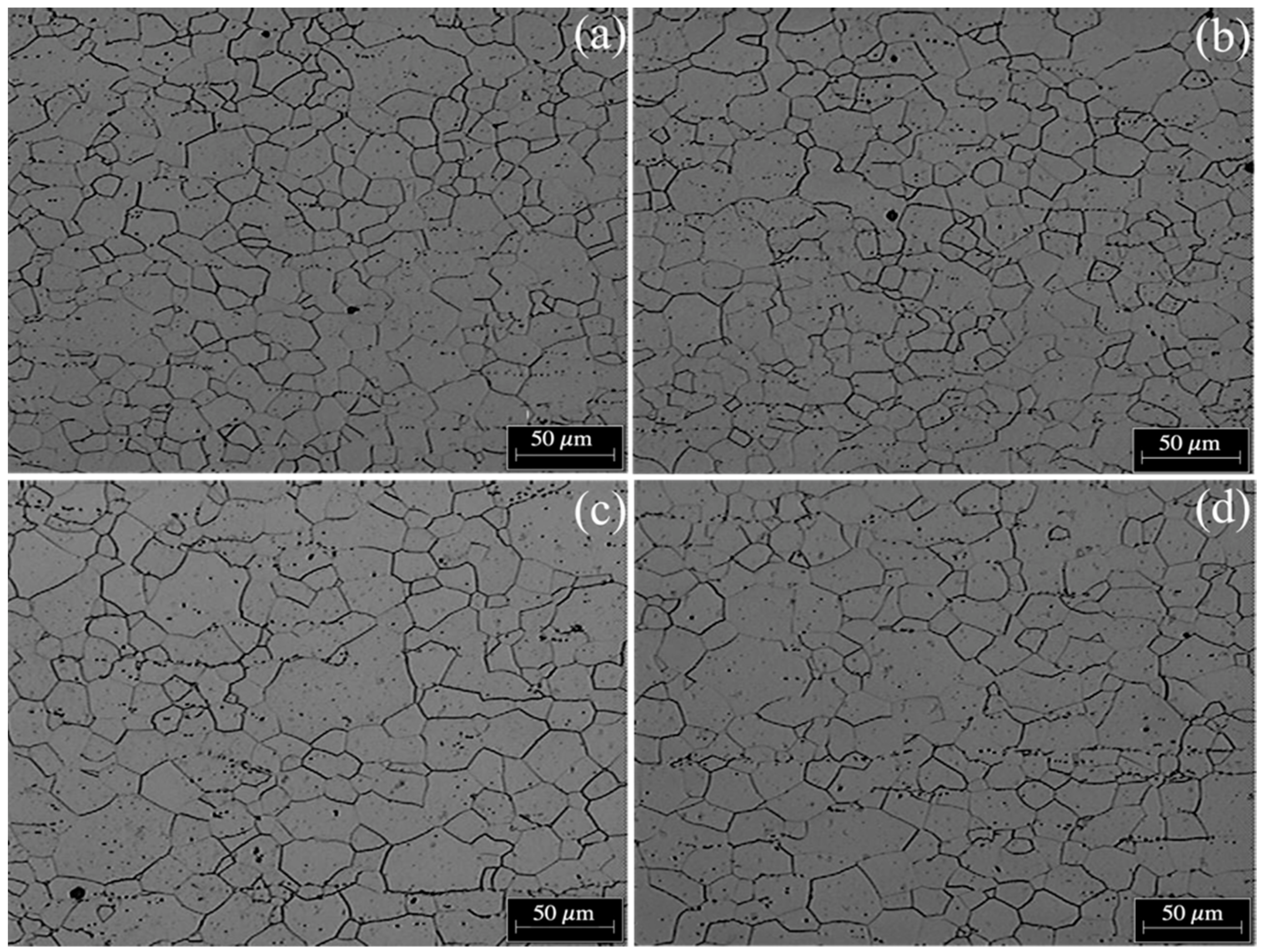

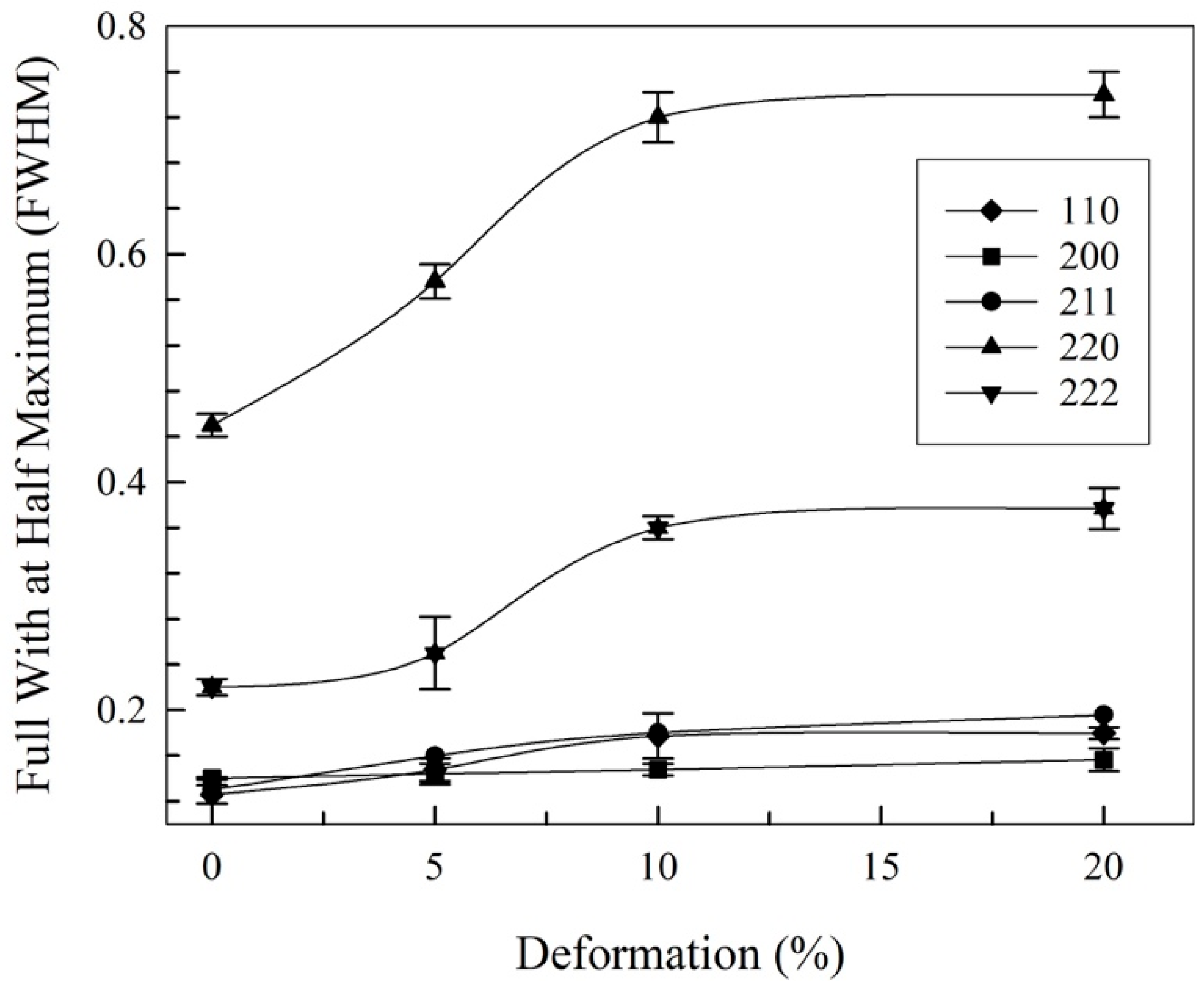
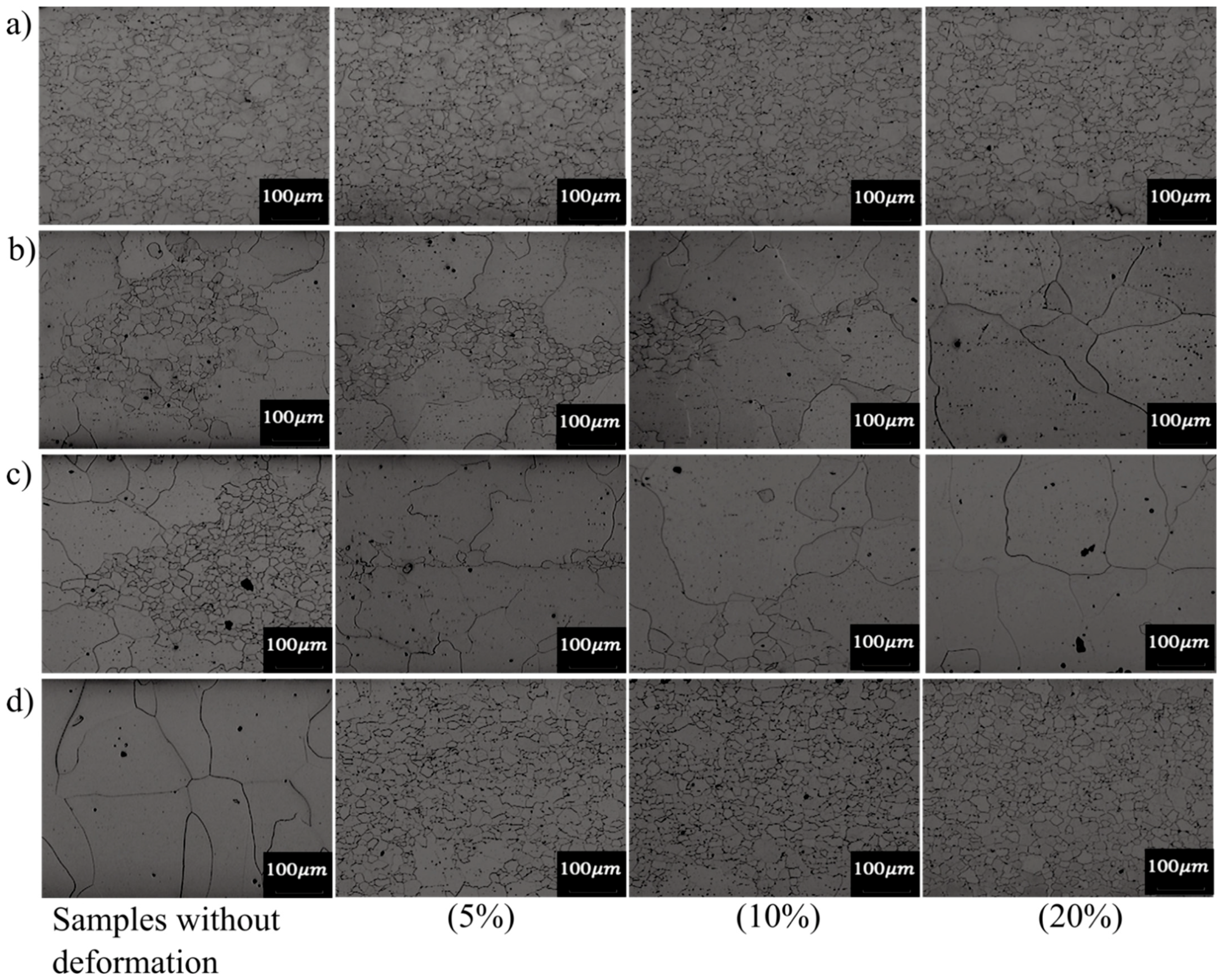

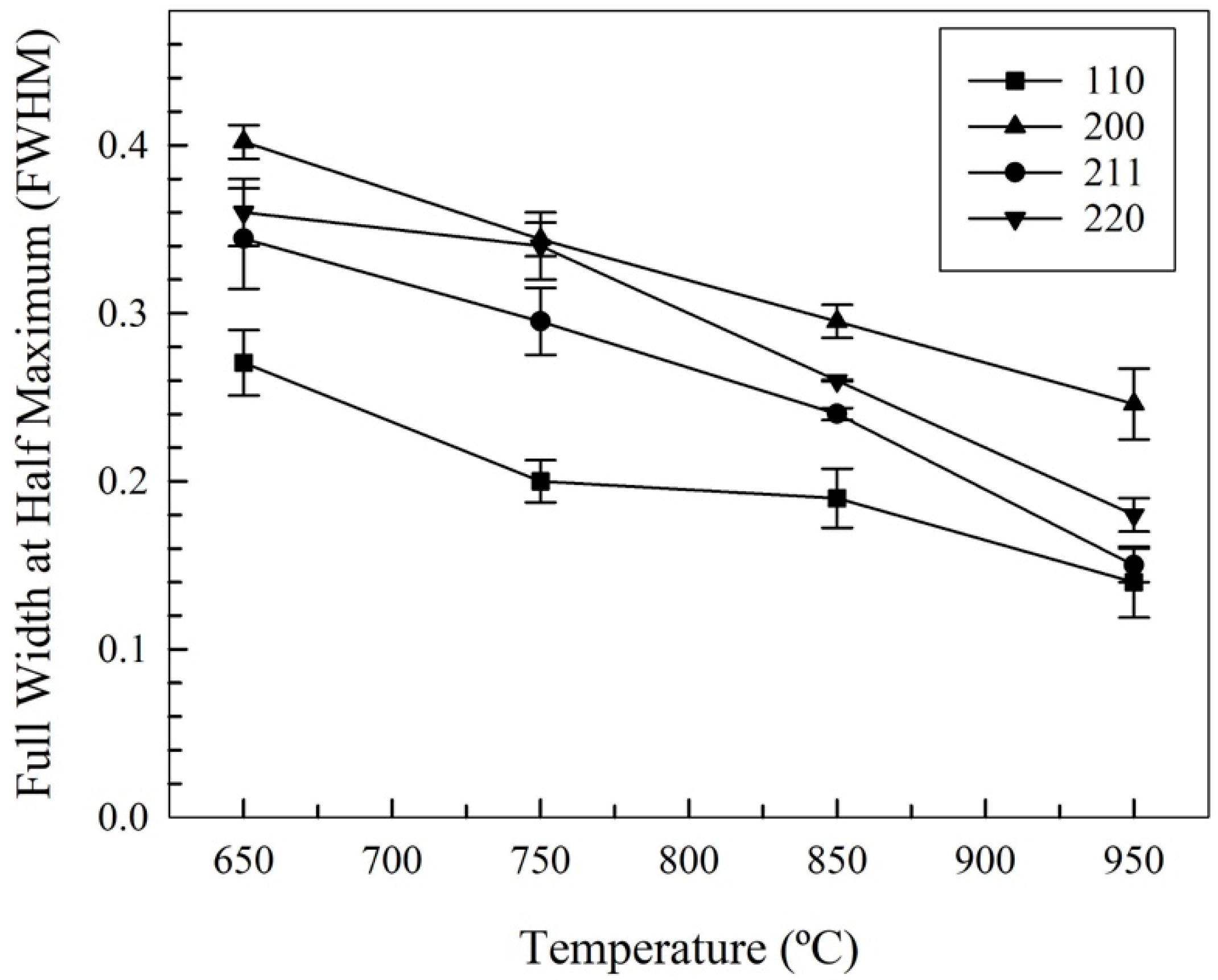
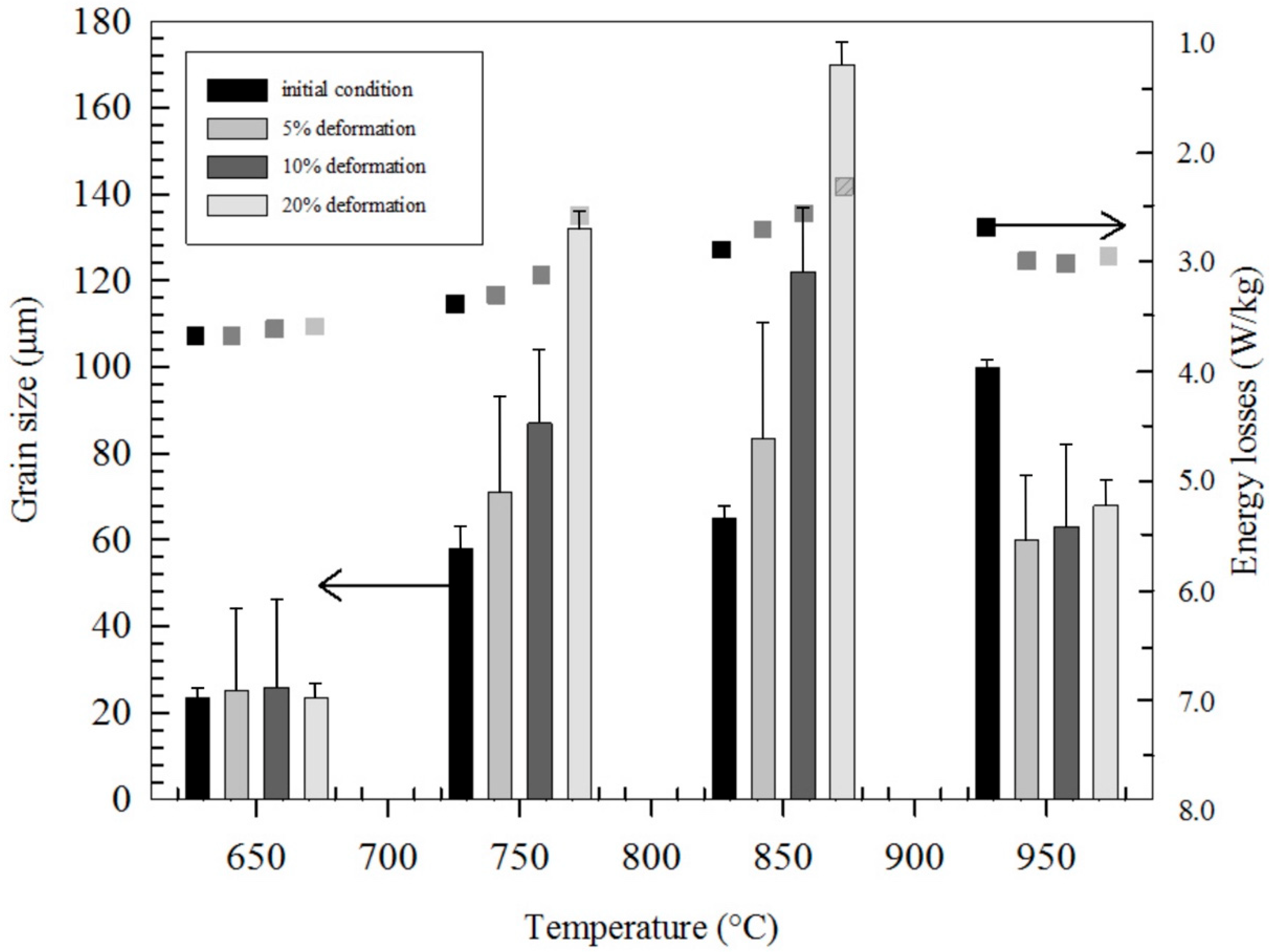
| Element | Si | C | Mn | Al | Cr | P | Mo | Ti | Nb | S | Fe |
|---|---|---|---|---|---|---|---|---|---|---|---|
| % | 0.383 | 0.03 | 0.594 | 0.217 | 0.053 | 0.043 | 0.018 | 0.003 | 0.0002 | <0.0005 | 98.56 |
Publisher’s Note: MDPI stays neutral with regard to jurisdictional claims in published maps and institutional affiliations. |
© 2022 by the authors. Licensee MDPI, Basel, Switzerland. This article is an open access article distributed under the terms and conditions of the Creative Commons Attribution (CC BY) license (https://creativecommons.org/licenses/by/4.0/).
Share and Cite
López-Granados, N.M.; Gutiérrez-Castañeda, E.J.; Salinas-Rodríguez, A. Effect of Cold Rolling Prior to Annealing on the Grain Size-Energy Losses Relationship in a Low Carbon Grain Non-Oriented Semi-Processed Electrical Steel. Metals 2022, 12, 1211. https://doi.org/10.3390/met12071211
López-Granados NM, Gutiérrez-Castañeda EJ, Salinas-Rodríguez A. Effect of Cold Rolling Prior to Annealing on the Grain Size-Energy Losses Relationship in a Low Carbon Grain Non-Oriented Semi-Processed Electrical Steel. Metals. 2022; 12(7):1211. https://doi.org/10.3390/met12071211
Chicago/Turabian StyleLópez-Granados, Nancy Margarita, Emmanuel José Gutiérrez-Castañeda, and Armando Salinas-Rodríguez. 2022. "Effect of Cold Rolling Prior to Annealing on the Grain Size-Energy Losses Relationship in a Low Carbon Grain Non-Oriented Semi-Processed Electrical Steel" Metals 12, no. 7: 1211. https://doi.org/10.3390/met12071211
APA StyleLópez-Granados, N. M., Gutiérrez-Castañeda, E. J., & Salinas-Rodríguez, A. (2022). Effect of Cold Rolling Prior to Annealing on the Grain Size-Energy Losses Relationship in a Low Carbon Grain Non-Oriented Semi-Processed Electrical Steel. Metals, 12(7), 1211. https://doi.org/10.3390/met12071211







